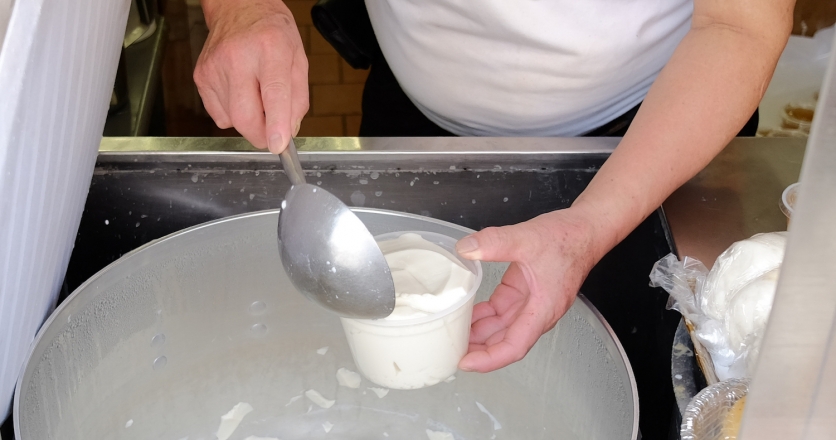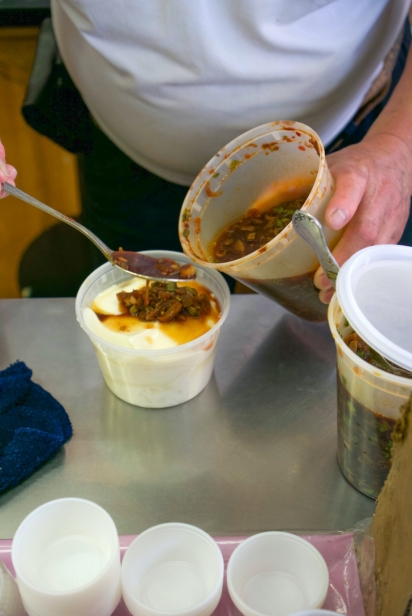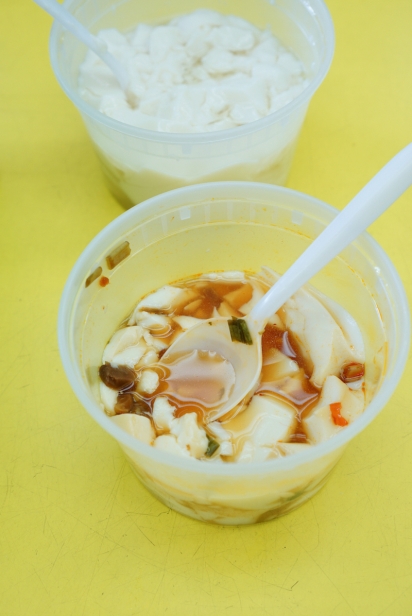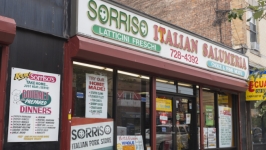The Proof is in the Soybean Pudding
Sandwiched between a Chinese jewelry shop and a Vietnamese beauty parlor on Roosevelt Avenue, near Flushing’s Main Street, the Soy Bean Chan Flower Shop (it’s “Chan,” though the awning says “Chen”) has lines out the door and off its tiny, dusty drive-by window during rush hour and on weekends. These queuing customers aren’t here for the flowers, but for one of the freshest, tastiest soybean puddings around. And the eponymous “Soy Bean Chan” (the only name he goes by) has been doling it out since the late 1990s, cultivating a loyal following and local recognition through the decades.
“We use the highest-quality, non-GMO soybeans,” says the ruddy, round-faced store owner through a translator as he flattens an empty 60-pound bag of Hunsty-brand beans against the cashier counter. He explains that he makes a limited batch every morning out of his Flushing commercial kitchen, boiling, grinding and squeezing the beans. “We do it all by hand. If you had a machine, it could be a lot more efficient and we could make more, but it wouldn’t be the same.”
And the proof, literally, is in the pudding.
Chan’s douhua cracks into big, white glaciers of tofu, not small mashed-potato-like mounds commonly found in dimsum restaurants and pastry shops, and imparts a clean, refreshing taste with every soft slurp. It’s a popular dish said to have originated in China and spread to Southeast Asia, and can be ordered on the streets of Taipei, Penang or Java for breakfast or a snack, cold or hot, with sweet or savory toppings depending on one’s cultural roots.
Chan offers three different toppings: the classic Taiwanese version served with a redolent brown sugar and golden ginger syrup; boiled whole peanuts for some crunch; and a red, savory sauce of tiny shrimp, cilantro, scallions and chili peppers.
“I have customers from Malaysia, Thailand, Vietnam, Philippines and other parts of the world, and they told me they wanted something new—something spicy—so that’s why I make that [last] one,” says Chan, who chose Flushing as his home base for its Asian population. When he immigrated to the United States around 1999, there was less competition and more opportunity for something “traditional and authentic” like douhua.
“Ever since I was a kid, I ate a lot of soybeans. My mom and dad used to tell me that they had a lot of nutritional value,” says Chan. “But our family was big, and we were poor. So we had to portion our soybeans. That’s why America looked so great. We used to see in magazines that there were a lot of soybeans in America. There was so much wealth to go around.”
The rest of his shop is devoted to the busy flower business, and shines with gold and jade figurines of Buddha, pigs, warriors, bonsai trees and lucky cats waving hello. Orchid plants and rose bouquets pop with shimmers of pink and red.
There’s an ebb and flow of douhua customers—a father with a ’tween son, several young professionals, a grandmother with a wide-brimmed red hat—around the tight tofu corner, measuring perhaps 10 by five feet. A bright yellow table can squeeze two diners in. Chan also sells fresh soy milk, fish balls, steamed buns, tea eggs and sesame rolls, but the bestseller is the simple, classic douhua.
He scoops ladles of tofu pudding from a steaming silver rice cooker into a small plastic container. He fills a small sauce container with ginger syrup, clicks the lid in place; places that atop the douhua with a plastic white spoon and ties it all together inside a plastic bag.
A line of four quickly forms again.










